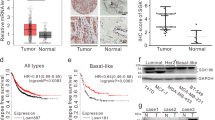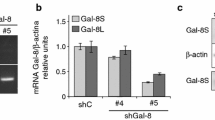Abstract
We demonstrated previously that the expression of the disaccharide, GalNAcβ1 → 4GlcNAc (LacdiNAc), on N-glycans of cell surface glycoproteins in MDA-MB-231 human breast cancer cells suppresses their malignant properties such as tumor formation in nude mice. Here, we report changes in the morphological appearance and adhesive properties of two kinds of clonal cells of MDA-MB-231 cells overexpressing β4-N-acetyl-galactosaminyltransferase 4. The clonal cells exhibited a cobble stone-like shape as compared to a spindle-like shape of the mock-transfected cells and the original MDA-MB-231 cells. This was associated with an increased expression of cell surface E-cadherin, a marker of epithelial cells, and a decreased expression of N-cadherin, vimentin, α-smooth muscle actin and ZEB1, markers of mesenchymal cells. In addition, the clonal cells showed a lower migratory activity compared to the mock-transfected cells by wound-healing assay. These results suggest that mesenchymal–epithelial transition may be occurring in these clonal cells. Furthermore, increased adhesion to extracellular matrix proteins such as fibronectin, collagen type I, collagen type IV, and laminin was observed. The clonal cells spread and enlarged, whereas the mock-transfected cells demonstrated poor spreading on laminin-coated plates in the absence of fetal calf serum, indicating that expression of LacdiNAc on cell surface glycoproteins results in changes in cell adhesive and spreading properties particularly to laminin.







Similar content being viewed by others
References
Adamczyk B, Jin C, Polom K, Muñoz P, Rojas-Macias MA, Zeeberg D, Borén M, Roviello F, Karlsson NG (2018) Sample handling of gastric tissue and O-glycan alterations in paired gastric cancer and non-tumorigenic tissues. Sci Rep 8:242
Alam N, Goel HL, Zarif MJ, Butterfield JE, Perkins HM, Sansoucy BG, Sawyer TK, Languino LR (2007) The integrin-growth factor receptor duet. J Cell Physiol 213:649–653
Anugraham M, Jacob F, Everest-Dass AV, Schoetzau A, Nixdorf S, Hacker NF, Fink D, Heinzelmann-Schwarz V, Packer NH (2017) Tissue glycomics distinguish tumour sites in women with advanced serous adenocarcinoma. Mol Oncol 11:1595–1615
Asada M, Furukawa K, Segawa K, Endo T, Kobata A (1997) Increased expression of highly branched N-glycans at cell surface is correlated with the malignant phenotypes of mouse tumor cells. Cancer Res 57:1073–1080
Austin P, Freeman SA, Gray CA, Gold MR, Vogl AW, Andersen RJ, Roberge M, Roskelley CD (2013) The invasion inhibitor sarasinoside A1 reverses mesenchymal tumor transformation in an E-cadherin-independent manner. Mol Cancer Res 11:530–540
Blick T, Widodo E, Hugo H, Waltham M, Lenburg ME, Neve RM, Tompson EW (2008) Epithelial mesenchymal transition traits in human breast cancer cell lines. Clin Exp Metastasis 25:629–642
Bray F, Ferlay J, Soerjomataram I, Siegel RL, Torre LA, Jemal A (2018) Global cancer statistics 2018: GLOBOCAN estimates of incidence and mortality worldwide for 36 cancers in 185 countries. CA Caner J Clin 68:394–424
Castillo LF, Tascón R, Lago Huvelle MR, Novack G, Llorens MC, Dos Santos AF, Shortrede J, Cabanillas AM, de Kier Bal, Joffé E, Labriola L, Peters MG (2016) Glypican-3 induces a mesenchymal to epithelial transition in human breast cancer cells. Oncotarget 7:60133–60154
Che MI, Huang J, Hung JS, Lin YC, Huang MJ, Lai HS, Hsu WM, Liang JT, Huang MC (2014) β1,4-N-acetylgalactosaminyltransferase III modulates cancer stemness through EGFR signaling pathway in colon cancer cells. Oncotarget 15:3673–3684
Colak S, Dijke P (2017) Targeting TGF-β-signaling in cancer. Trend Cancer 3:56–71
Derynck R, Zhang YE (2003) Smad-dependent and Smad-independent pathways in TGF-β family signalling. Nature 425:577–584
Fukushima K, Satoh T, Baba S, Yamashita K (2010) α1,2-Fucosylated and β-N-acetylgalactosaminylated prostate-specific antigen as an efficient marker of prostatic cancer. Glycobiology 20:452–460
Furukawa K, Kitamura N, Sato T, Hiraizumi S (2001) Differentiation-associated expression of β-N-acetylgalactosaminylated N-linked oligosaccharides in mammary epithelial cells. Adv Exp Med Biol 491:313–323
Gu J, Taniguchi N (2008) Potential of N-glycan in cell adhesion and migration as either a positive or negative regulator. Cell Adh Migr 2:243–245
Gu J, Isaji T, Xu Q, Kariya Y, Gu W, Fukuda T, Du Y (2012) Potential roles of N-glycosylation in cell adhesion. Glycoconj J 29:599–607
Gupta I, Sareyeldin RM, Al-Hashimi I, Al-Thawadi HA, Al Farsi H, Vranic S, Al Moustafa AE (2019) Triple negative breast cancer profile, from gene to microRNA, in relation to ethnicity. Cancers (Basel) 11:363
Hirano K, Zuber C, Roth J, Ziak M (2003) The proteasome is involved in the degradation of different aquaporin-2 mutants causing nephrogenic diabetes insibidus. Am J Path 163:111–120
Hirano K, Matsuda A, Shirai T, Furukawa K (2014) Expression of LacdiNAc groups on N-glycans among human tumor is complex. BioMed Res Int. https://doi.org/10.1155/2014/981627
Hirano K, Matsuda A, Kuji R, Nakandakari S, Shirai T, Furukawa K (2015) Enhanced expression of the β4-N-acetylgalactosaminyltransferase 4 gene impairs tumor growth of human breast cancer cells. Biochem Biophys Res Commun 461:80–85
Hou S, Isaji T, Hang Q, Im S, Fukuda T, Gu J (2016) Distinct effects of β1 integrin on cell proliferation and cellular signaling in MDA-MB-231 breast cancer cells. Sci Rep 6:18430
Hsu WM, Che MI, Liao YF, Chang HH, Chen CH, Huang YM, Jeng YM, Huang J, Quon MJ, Lee H, Huang HC, Huang MC (2011) B4GALNT3 expression predicts a favorable prognosis and suppresses cell migration and invasion via β1-integrin signaling in neuroblastoma. Am J Path 179:1394–1404
Huang J, Liang JT, Huang HC, Shen TL, Chen HY, Lin NY, Che MI, Lin WC, Huang MC (2007) β1,4-N-acetylgalactosaminyltransferase III enhances malignant phenotypes of colon cancer cells. Mol Cancer Res 5:543–552
Hwang SY, Park S, Kwon Y (2019) Recent therapeutic trends and promising targets in triple negative breast cancer. Pharmacol Ther 199:30–57
Isaji T, Gu J, Nishiuchi R, Zhao Y, Takahashi M, Miyoshi E, Honke K, Sekiguchi K, Taniguchi N (2004) Introduction of bisecting GlcNAc into integrin α5β1 reduces ligand binding and down-regulates cell adhesion and cell migration. J Biol Chem 279:19747–19754
Isaji T, Sato Y, Zhao Y, Miyoshi E, Wada Y, Taniguchi N, Gu J (2006) N-glycosylation of the β-propeller domain of the integrin α5 subunit is essential for α5β1 heterodimerization, expression on the cell surface, and its biological function. J Biol Chem 281:33258–33267
Kitamura N, Guo S, Sato T, Hiraizumi S, Taka J, Ikekita M, Sawada S, Fujisawa H, Furukawa K (2003) Prognostic significance of reduced expression of β-N-acetyl- galactosaminylated N-linked oligosaccharides in human breast cancer. Int J Cancer 105:533–541
Lamouille S, Xu J, Derynck R (2014) Molecular mechanisms of epithelial–mesenchymal transition. Nat Rev Mol Cell Biol 15:178–196
Li X, Wang X, Tan Z, Chen S, Guan F (2016) Role of glycans in cancer cells undergoing epithelial–mesenchymal transition. Front Oncol 6:33
Lin D, Kuang G, Wan J, Zhang X, Li H, Gong X, Li H (2017) Luteolin suppresses the metastasis of triple-negative breast cancer by reversing epithelial-to-mesenchymal transition via downregulation of β-catenin expression. Oncol Rep 37:895–902
Lu J, Isaji T, Im S, Fukuda T, Hashii N, Takakura D, Kawasaki N, Gu J (2014) β-Galactoside α2,6-sialyltranferase 1 promotes transforming growth factor-β-mediated epithelial-mesenchymal transition. J Biol Chem 289:34627–34641
Machado E, Kandzia S, Carilho R, Altevogt P, Conradt HS, Costa J (2011) N-Glycosylation of total cellular glycoproteins from the human ovarian carcinoma SKOV3 cell line and of recombinantly expressed human erythropoietin. Glycobiology 21:376–386
Miranti CK, Brugge JS (2002) Sensing the environment: a historical perspective on integrin signal transduction. Nat Cell Biol 4:E83–E90
Nakata N, Furukawa K, Greenwalt DE, Sato T, Kobata A (1993) Structural study of the sugar chains of CD36 purified from bovine mammary epithelial cells: occurrence of novel hybrid-type sugar chains containing the Neu5Acα2 → 6GalNAcβ1 → 4GlcNAc and the Manα1 → 2Manα1 → 3Manα1 → 6Man groups. Biochemistry 32:4369–4383
Sarrió D, Rodriguez-Pinilla SM, Hardisson D, Cano A, Moreno-Bueno G, Palacios J (2008) Epithelial-mesenchymal transition in breast cancer relates to the basal-like phenotype. Cancer Res 68:989–997
Sasaki N, Shinomi M, Hirano K, Ui-Tei K, Nishihara S (2011) LacdiNAc (GalNAcβ1-4GlcNAc) contributes to self-renewal of mouse embryonic stem cells by regulating leukemia inhibitory factor/STAT3 signaling. Stem Cell 29:641–650
Sato T, Taka J, Aoki N, Matsuda T, Furukawa K (1997) Expression β-N-acetylgalactosaminylated N-linked sugar chain is associated with functional differentiation of bovine mammary gland. J Biochem 122:1068–1073
Sato T, Gotoh M, Kiyohara K, Kameyama A, Kubota T, Kikuchi N, Ishizuka Y, Iwasaki H, Togayachi A, Kudo T, Ohkura T, Nakanishi H, Narimatsu H (2003) Molecular cloning and characterization of a novel human β1,4-N-acetylgalactosaminyl-transferase, β4GalNAc-T3, responsible for the synthesis of N, N′-diacetyl-lactosediamine, GalNAcβ1-4GlcNAc. J Biol Chem 278:47534–47544
Thiery JP, Sleeman JP (2006) Complex networks orchestrate epithelial-mesenchymal transitions. Nat Rev Mol Cell Biol 7:131–142
van ’t Veer LJ, Dai H, van de Vijver MJ, He YD, Hart AA, Mao M, Peterse HL, van der Kooy K, Marton MJ, Witteveen AT, Schreiber GJ, Kerkhoven RM, Roberts C, Linsley PS, Bernards R, Friend SH (2002) Gene expression profiling predicts clinical outcome of breast cancer. Nature 415:530–536
Varki A (1993) Biological roles of oligosaccharides: all of the theories are correct. Glycobology 3:97–130
Wells A, Yates C, Shepard CR (2008) E-cadherin as an indicator of mesenchymal to epithelial reverting transitions during the metastatic seeding of disseminated carcinomas. Clin Exp Metastasis 25:621–628
Wu Y, Sarkissyan M, Vadgama JV (2016) Epithelial–mesenchymal transition and breast cancer. J Clin Med 5(2):13. https://doi.org/10.3390/jcm5020013
Xu Q, Isaji T, Lu Y, Gu W, Kondo M, Fukuda T, Du Y, Gu J (2012) Roles of N-acetylglucosaminyltransferase III in epithelial-to-mesenchymal transition induced by transforming growth factor β1 (TGF-β1) in epithelial cell lines. J Biol Chem 287:16563–16574
Xu Q, Niu X, Wang W, Yang W, Du Y, Gu J, Song L (2017) Specific N-glycan alterations are coupled in EMT induced by different density cultivation of MCF 10A epithelial cells. Glycoconj J 34:219–227
Acknowledgements
We are grateful to Dr. Tomoya Isaji and Dr. Jianquo Gu at Tohoku Medical and Pharmaceutical University, Japan, for their generous gift of anti-β1-integrin antibody.
Author information
Authors and Affiliations
Corresponding author
Ethics declarations
Conflict of interest
The authors declare no conflict of interest.
Additional information
Publisher's Note
Springer Nature remains neutral with regard to jurisdictional claims in published maps and institutional affiliations.
Rights and permissions
About this article
Cite this article
Hirano, K., Takada, Y. & Furukawa, K. LacdiNAcylation of N-glycans in MDA-MB-231 human breast cancer cells results in changes in morphological appearance and adhesive properties of the cells. Histochem Cell Biol 153, 17–26 (2020). https://doi.org/10.1007/s00418-019-01822-3
Accepted:
Published:
Issue Date:
DOI: https://doi.org/10.1007/s00418-019-01822-3




